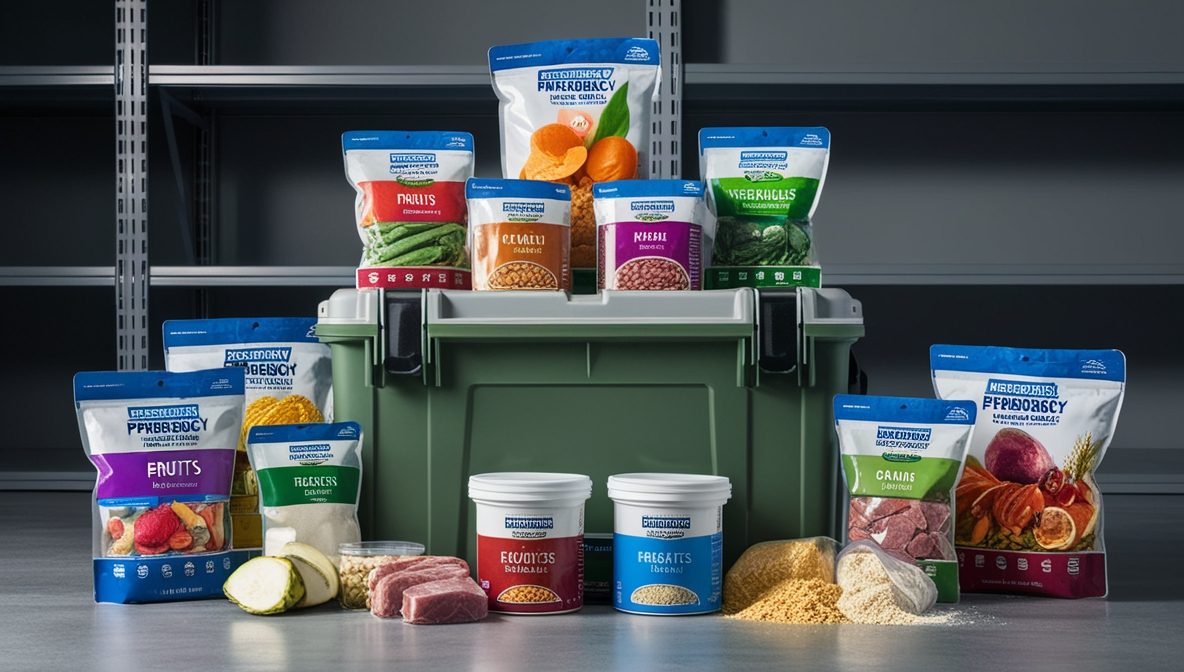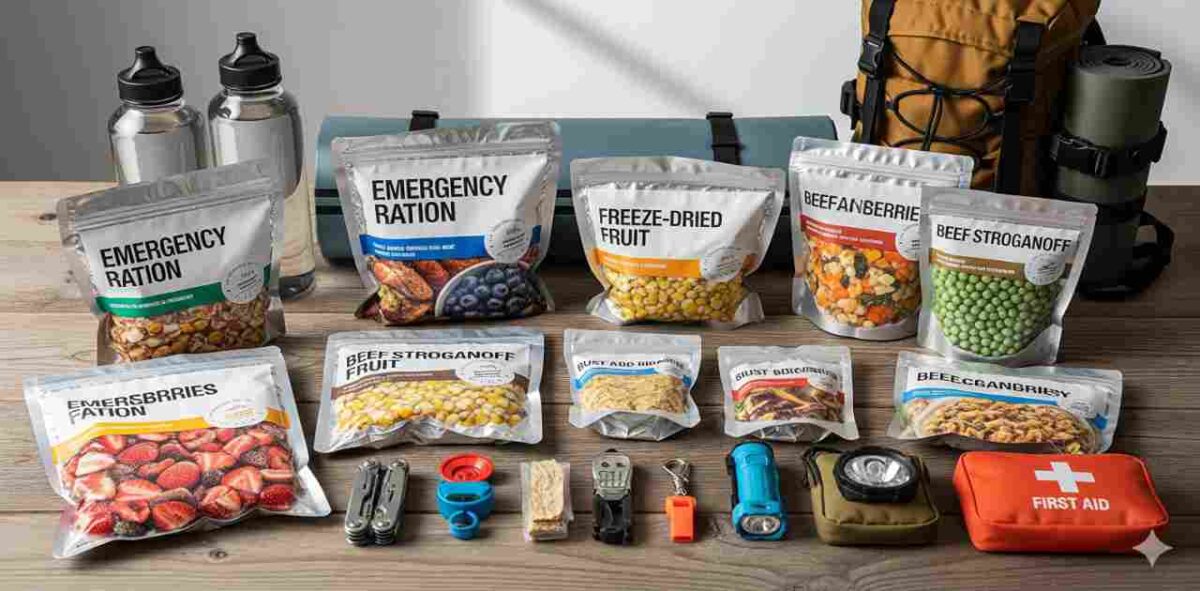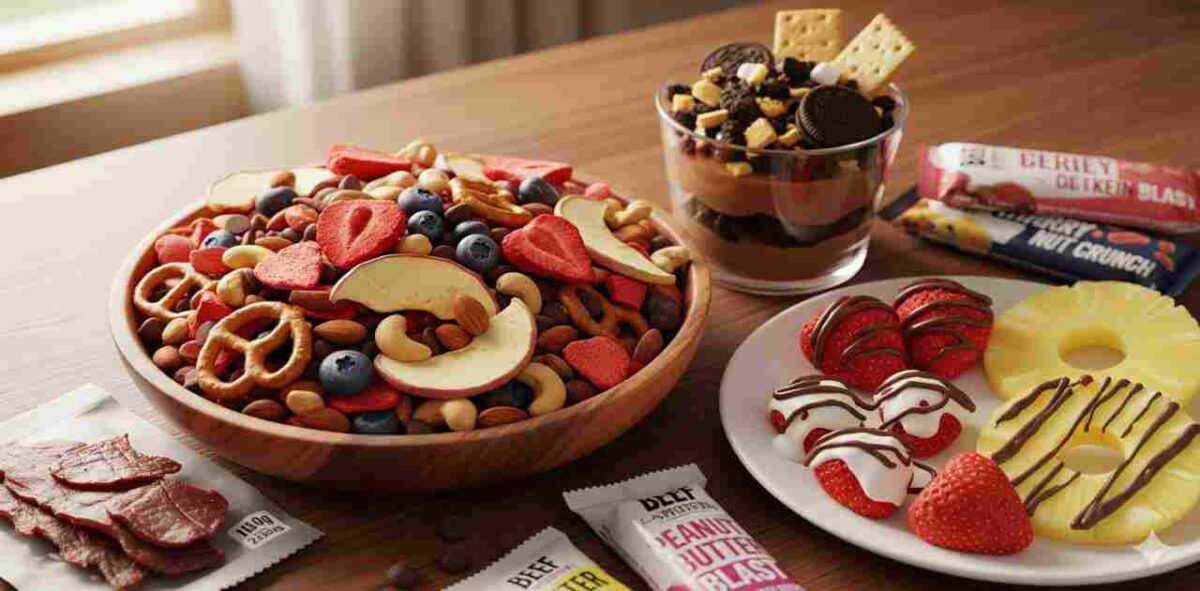When it comes to emergency preparedness, food security is one of the most critical aspects to consider. Freeze-dried emergency food essentials stand out as a reliable solution due to their lightweight nature, exceptional shelf life of up to 25 years, and ability to retain vital nutrients. Unlike canned or dehydrated foods, freeze-dried options maintain their original flavor, texture, and nutritional integrity, making them ideal for long-term storage and quick meal preparation during crises.
The process of freeze-drying, also known as lyophilization, involves removing moisture from food through sublimation while preserving its structure and nutrients. This advanced technology is widely used not only for survival foods but also in pharmaceutical and biotech industries. If you want to understand the technical side of this process, you can explore our guide on lyophilization process efficiency best practices, which provides deeper insights into how freeze-drying ensures product stability.
With options ranging from fruits, vegetables, and meats to powdered dairy and grains, freeze-dried foods provide balanced nutrition and convenience—essentials for any emergency food supply kit.
What Is Freeze-Dried Emergency Food?
Freeze dried foods are critical for emergency preparedness because they last much longer than fresh food while maintaining their nutritional integrity. Through a unique process, water is removed from food, making it lightweight and compact, yet it can be easily rehydrated with hot water to provide a wholesome meal in minutes.
How Does Freeze Drying Work?
The freeze drying process involves freezing food and then reducing the surrounding pressure to allow the frozen water in the food to sublimate, transforming from a solid to a gas. This eliminates moisture, slows down spoilage, and shrinks food in size without compromising its shape. When water is added back, the food returns to its original form, making it quick to prepare.
Nutritional Benefits of Freeze-Dried Foods
Freeze drying retains essential macro- and micronutrients. These foods offer the same quality proteins, healthy fats, and carbohydrates as fresh foods, providing the energy needed in emergency situations. The process also preserves vitamins and minerals, making freeze-dried meals an excellent source of nutrition when fresh food isn’t available.
The 25-Year Shelf Life Advantage
One of the most significant benefits of freeze-dried food is its impressive shelf life. Properly stored, these foods can remain edible for up to 25 years. By sealing them in airtight, moisture-proof packaging and storing them in a cool, dark space, you prevent bacterial growth and slow oxidation, preserving your emergency food supply for decades.
If you are looking to expand your knowledge of freeze-drying processes, check out this helpful guide on how to freeze-dry eggs for long-term storage. This resource can give you more insight into practical applications for long-term food preservation.
Lightweight and Compact for Portability
Freeze-dried food weighs significantly less than canned or fresh food because the water has been removed. This makes it easy to carry in emergency kits or bug-out bags. Whether you’re evacuating or staying put, you can store a large amount of food in a small space, ideal for unpredictable situations.
Quick and Easy Preparation
One of the biggest advantages of freeze-dried food is its simplicity. Just add near-boiling water, wait for 5–10 minutes, and your meal is ready. No cooking skills or special equipment are required, making it ideal in emergencies when utilities might be compromised.
Selecting the Best Freeze-Dried Foods for Emergency Supplies
When building an emergency food supply, prioritize freeze-dried foods that provide optimal nutrition, taste, and shelf life. Here’s what to look for:
High-Calorie, Nutrient-Rich Meals
- Aim for 2,000–2,500 calories per person per day in emergency situations.
- Look for meals with high-calorie content that meet these requirements.
Balanced Macronutrients and Micronutrients
- Ensure meals have a good balance of protein, fats, and carbohydrates.
- Check for adequate vitamin and mineral content to avoid deficiencies over time.
Quality Ingredients
- Choose frozen foods with whole, natural ingredients and no artificial additives.
- Select non-GMO and minimally processed options for optimal nutrition.
Taste and Palatability
- Taste is important, especially in high-stress situations. Sample freeze-dried meals beforehand or read reviews to ensure they have good flavor and texture.
- Having palatable meals can help maintain morale during a crisis.
Packaging for Long Shelf Life
- Select freeze dried foods in high-barrier film packaging, which keeps moisture out and preserves shelf life.
- Ensure the manufacturer stamps a clear expiration date on the packaging to confirm multi-year shelf stability.
Essential Freeze Dried Foods for a Balanced Emergency Supply
Freeze Dried Fruits and Vegetables
Fruits and vegetables are crucial for providing essential vitamins and minerals. Freeze dried varieties such as carrots, peas, corn, apples, and strawberries retain their nutritional value and are easy to store.
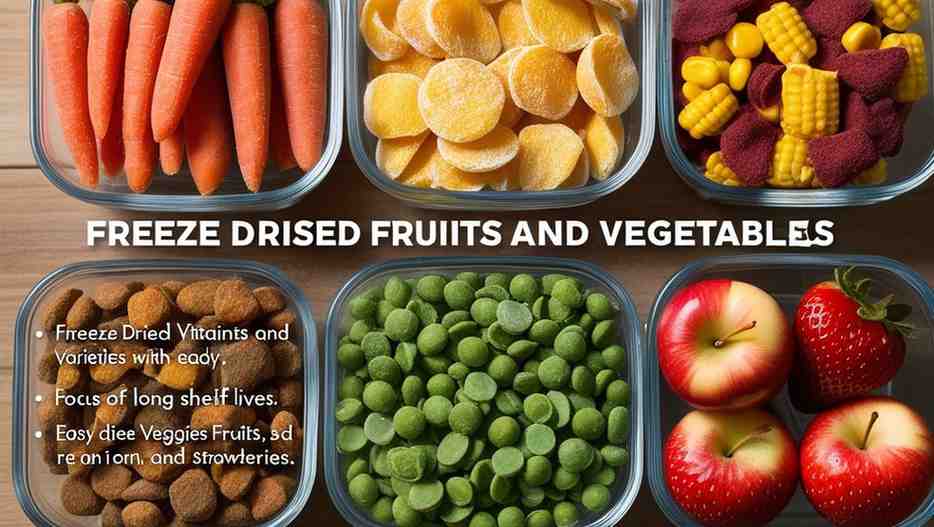
Key Tips:
- Prioritize nutrient-dense options with long shelf lives.
- Focus on items rich in Vitamin A, Vitamin C, iron, and potassium.
- Choose fruits and veggies that rehydrate well and can be eaten on their own or added to meals.
Protein-Rich Beans and Legumes
Beans and legumes like black beans, lentils, and chickpeas are an excellent source of protein and fiber. They have long shelf lives and can be used to make various nutritious meals like soups, chili, or hummus.
Powdered Dairy: Milk and Eggs
Dairy alternatives like powdered milk and eggs are valuable for their high protein and calcium content. Powdered milk can be used as a beverage or in cooking, while powdered eggs can be rehydrated and used in a range of recipes, from omelets to baked goods.
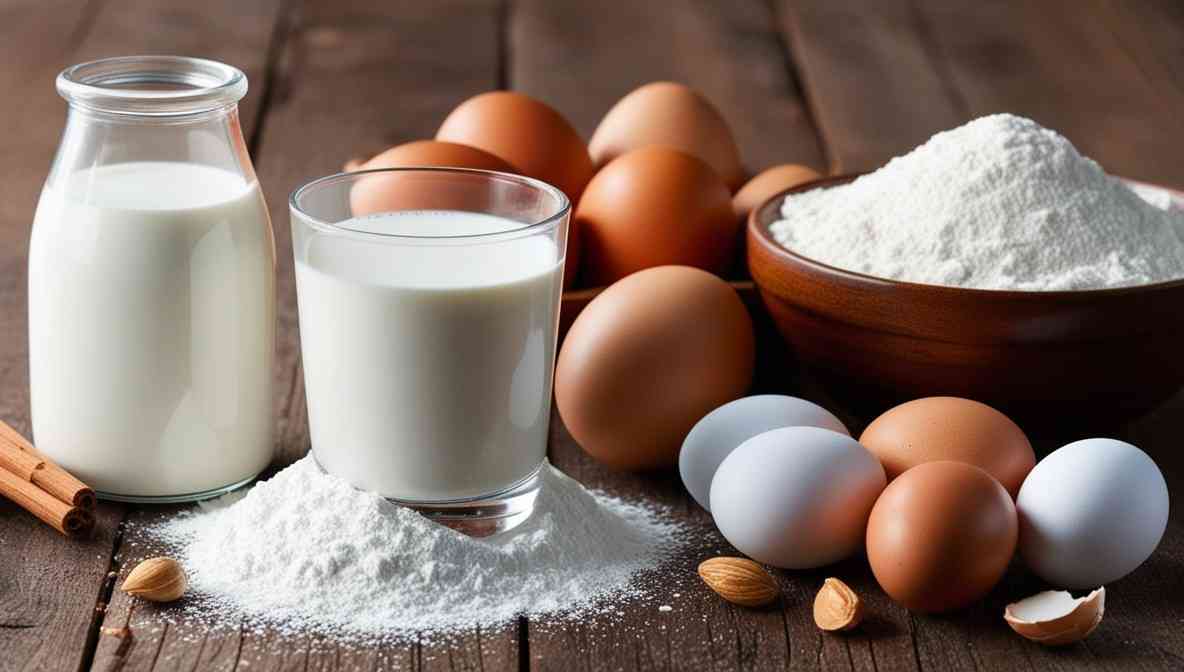
Freeze Dried Meats
Protein is a critical component in any emergency food supply, and freeze-dried meats such as chicken, beef, and fish offer a high-quality protein source. When choosing meats, prioritize:
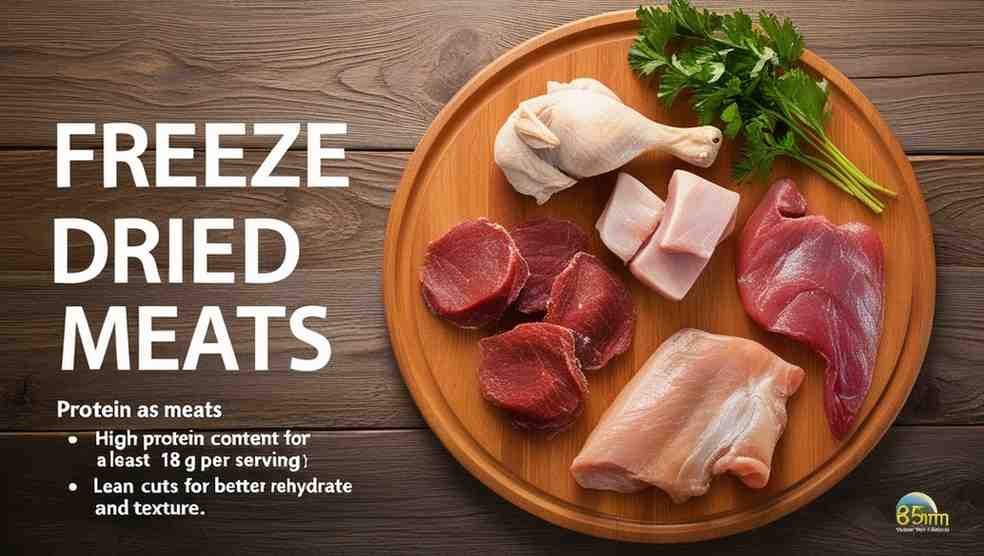
- High protein content (at least 18 g per serving).
- Lean cuts for better rehydration and texture.
Grains for Energy
Grains such as rice, oats, pasta, and quinoa are key sources of carbohydrates and provide the energy needed during emergencies. Whole grains are preferable for their nutritional benefits, but even white rice has a long shelf life when stored correctly.
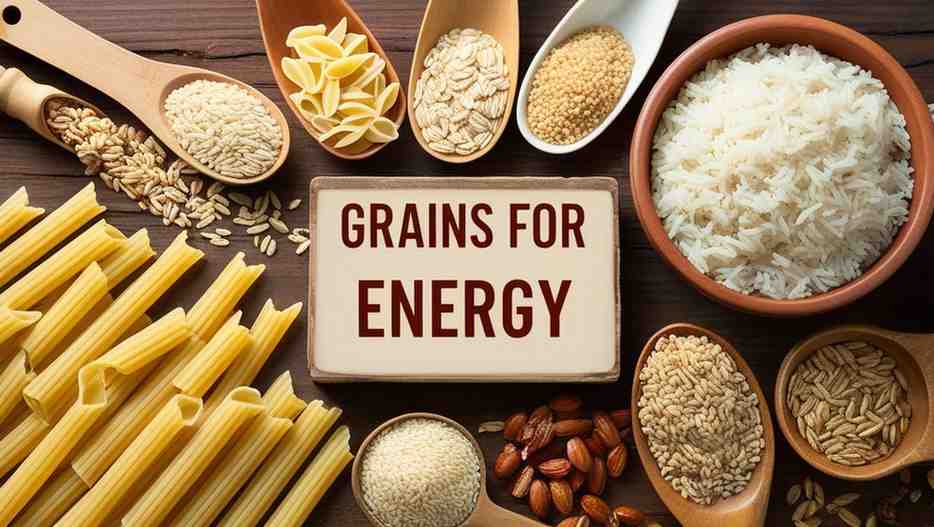
Creating Balanced Meals with Freeze-Dried Foods
It’s easy to mix and match freeze-dried ingredients to create balanced meals. Here are a few ideas:
- Oatmeal with Fruit: Combine freeze-dried fruits like strawberries or blueberries with instant oatmeal for a nutritious breakfast.
- Scrambled Eggs with Veggies: Mix powdered eggs with rehydrated, freeze-dried vegetables for a quick, protein-packed meal.
- Hearty Soup: Rehydrate beans, vegetables, and freeze dried meat to make a warming, nutritious soup.
- Pasta with Meat and Veggies: Combine rehydrated freeze-dried pasta, meat, and vegetables to make a satisfying, energy-dense meal.
Nourishing Lunch & Dinner Combinations
Here are some easy and nutritious ideas for soups, chili, rice bowls, and skillet meals using freeze-dried ingredients:

- Chili: Combine freeze-dried ground beef, beans, corn, tomatoes, peppers, and your favorite seasonings to make a hearty chili. You can enjoy it on its own or serve it over rice for a complete meal.
- Rice Bowls: Create a quick and simple fried rice with freeze dried carrots, peas, corn, and eggs. Add soy sauce or teriyaki sauce, and include a protein like freeze-dried chicken for added flavor and nutrition.
- Skillet Meals: Sauté rehydrated freeze-dried meat like chicken with vegetables such as broccoli and carrots. Serve over rice or pasta for a satisfying dish.
- Hearty Soups: Use freeze-dried vegetables, beans, pasta, and broth to whip up a variety of soups like minestrone, vegetable soup, or chicken noodle soup.
Snacks & Desserts: Satisfying Cravings
Here are some ideas for sweet and savory snacks that can help balance your nutrition:
- Trail mixes: Make your own trail mix by combining freeze-dried fruits, pretzels, chocolate chips, nuts, and seeds for a tasty, nutrient-packed snack.
- Fruit Snacks: Rehydrate freeze dried apple slices, strawberries, or pineapple for a sweet treat. You can also dip them in chocolate or yogurt for added indulgence.
- Puddings: Mix freeze-dried milk with instant pudding mix, then top it with crushed cookies or graham crackers for a quick dessert.
- Jerky and Bars: Keep jerky and protein bars on hand for a protein-rich, filling snack when you need something more substantial.
Advantages of Freeze-Dried Food
- Long Shelf Life – Freeze-dried foods can last 10–25 years when properly stored.
- Lightweight – Since 98–99% of the water is removed, the food becomes very light, making it easy to transport.
- Retains Nutrients – Unlike other preservation methods, freeze-drying keeps most vitamins, minerals, and antioxidants intact.
- Maintains Original Shape – The structure of the food is preserved, unlike dehydrated or canned foods.
- Great Taste – Flavors remain close to fresh because sublimation prevents major changes in taste.
- Quick Rehydration – Food can be restored to its near-original state just by adding water.
- Minimal Preservatives Needed – Freeze-drying naturally inhibits bacterial growth, reducing the need for chemical preservatives.
- Portable for Travel – Ideal for camping, hiking, or emergency supplies due to its lightweight nature.
- Compact Storage – Reduced weight and volume make storage more space-efficient.
- Extended Seasonal Availability – Seasonal fruits, vegetables, or meals can be enjoyed year-round.
- Convenient for Cooking – Meals or ingredients are easy to prepare and rehydrate quickly.
- Reduced Spoilage – Low moisture prevents mold, yeast, and bacteria growth.
- Retains Color & Appearance – Freeze-dried food looks more like the fresh version compared to other drying methods.
- Variety of Options – Almost any food can be freeze-dried: fruits, vegetables, meats, dairy, and full meals.
- No Refrigeration Needed – Once sealed, freeze-dried food can be stored at room temperature.
- Crispy Snack Option – Some foods like fruits are enjoyed directly in their dry form as crunchy snacks.
- Better Digestibility – Freeze-drying maintains food fibers, making digestion easier than canned options.
- Allergy-Safe Storage – Special diets (gluten-free, lactose-free, etc.) can be stored safely for long periods.
- Emergency Preparedness – Essential for disaster survival kits and long-term food storage.
- Reduces Food Waste – Allows surplus produce to be preserved instead of spoiling.
Conclusion: Secure Your Long-Term Food Supply with Freeze-Dried Essentials
Building a reliable freeze-dried emergency food supply ensures peace of mind during uncertain times. Freeze dried foods are indispensable for building an emergency food supply that is lightweight, long-lasting, and nutritious. By selecting a variety of freeze-dried fruits, vegetables, proteins, and grains, you can ensure your family stays fed and healthy, even in prolonged disaster scenarios. Proper storage and regular rotation will keep your supply fresh and ready for use for up to 25 years, offering peace of mind in uncertain times..
Proper storage methods—such as airtight packaging, moisture control, and temperature regulation—are key to maximizing their shelf life. For those curious about how storage impacts quality, check out our detailed article on GMP freeze-drying guidelines, which outlines critical practices for maintaining food safety and integrity.
Whether for natural disasters, camping, or long-term preparedness, freeze-dried foods are a smart investment in security and survival.
Summary
- Freeze-dried emergency foods are lightweight, nutrient-rich, and can last up to 25 years.
- The freeze-drying process removes moisture while preserving flavor, structure, and nutrients.
- Essential options include freeze-dried fruits, vegetables, meats, grains, legumes, and powdered dairy.
- Benefits include long shelf life, compact storage, portability, and quick rehydration.
- Proper packaging and storage are critical to maintain quality—learn more in our guide on freeze-drying process parameters.
- A balanced emergency food kit should combine calorie-dense meals with nutrient-rich ingredients.
FAQs on Freeze-Dried Emergency Food Essentials
Is freeze-dried food good for an emergency?
Yes, freeze-dried food is excellent for emergency situations. It has a long shelf life of up to 25 years, making it perfect for long-term storage. Freeze-dried foods are lightweight, easy to store, and retain most of their nutritional value. They can be quickly rehydrated with water, making them ideal for emergencies when fresh food may not be available and cooking resources are limited.
What foods should I freeze-dry?
Some of the best foods to freeze-dry include fruits like strawberries, apples, and blueberries, vegetables such as carrots, peas, and corn, proteins like beef, chicken, and fish, dairy products such as milk and eggs, and complete meals like soups, stews, and casseroles. These items retain their flavor and nutrients after freeze-drying and can be easily rehydrated when needed.
What foods are good for emergency preparedness?
For emergency preparedness, you should focus on freeze-dried foods that offer a balance of nutrition, ease of storage, and long shelf life. Some good options include:
- Freeze-dried fruits and vegetables for essential vitamins and minerals
- Protein sources like freeze-dried meats, beans, and legumes
- Grains such as rice, oats, and pasta for carbohydrates and energy
- Powdered dairy products like milk and eggs for added protein and calcium
- Ready-made freeze-dried meals like soups, chili, and stews
These foods will help maintain balanced nutrition during an emergency situation.
What are the five foods on which we apply the freeze-drying technique?
The five common foods often freeze-dried are:
- Fruits: apples, strawberries, and bananas are popular choices.
- Vegetables: peas, carrots, and corn are frequently freeze-dried.
- Meat: Chicken, beef, and fish are freeze-dried to preserve protein.
- Dairy: Milk and eggs are freeze-dried to provide essential calcium and protein.
- Meals: Soups, stews, and casseroles are often freeze-dried for convenience in emergencies.
These foods maintain their flavor and nutritional content, making them great for long-term storage.
What makes freeze-dried food better for emergencies?
Freeze-dried food is lightweight, has a shelf life of up to 25 years, and retains nutrients, flavor, and texture better than dehydrated or canned foods. It also rehydrates quickly with just water, making it ideal for emergencies.
How long do freeze-dried foods really last?
When stored properly in airtight, moisture-proof packaging and kept in a cool environment, freeze-dried foods can last between 20–25 years without losing quality.
Are freeze-dried foods healthy?
Yes. Freeze-drying preserves most vitamins, minerals, and antioxidants, keeping the food nutritionally close to its fresh state. Unlike canned foods, they require little to no preservatives.
Do freeze-dried foods need refrigeration?
No. Freeze-dried foods do not need refrigeration once sealed. They can be stored at room temperature in a cool, dry place, making them highly convenient for emergency kits.
What types of food can be freeze-dried for emergency use?
Almost any food can be freeze-dried, including fruits, vegetables, meats, grains, dairy products, and even complete meals. Popular emergency staples include freeze-dried fruits, beans, rice, pasta, and soups.
How do you prepare freeze-dried foods?
Simply add water (hot or cold depending on the food) to rehydrate. Within minutes, the food regains its original taste, texture, and nutritional value, making it quick and easy to prepare in emergencies.
Are freeze-dried foods safe for children and older people,?
Yes. Freeze-dried foods are safe, nutritious, and easy to digest, making them suitable for all age groups, including children and older people,.
How do freeze-dried foods compare to dehydrated foods?
Freeze-dried foods last longer, retain more nutrients, and taste closer to fresh food than dehydrated foods. Dehydration removes 90–95% of water, while freeze-drying removes 98–99%, resulting in longer shelf life.
Can I make my own freeze-dried foods at home?
Yes, but it requires a home freeze-dryer machine, which can be expensive. Many people prefer purchasing ready-made emergency food packs due to cost and convenience.
Why are freeze-dried foods essential for disaster preparedness?
In emergencies, food security and nutrition are vital. Freeze-dried foods ensure you have lightweight, easy-to-store, nutrient-rich meals that can be prepared quickly without refrigeration or complex cooking.
